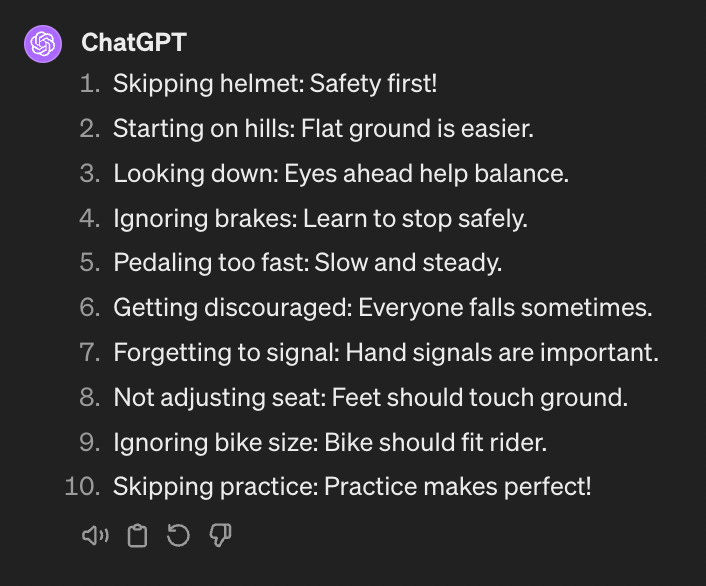Ahoy Digital Writers!
If you just tell people the right way to do something…
They’ll think, “Ok, I got this.”
And move on. Because, it makes sense.
Job done, right?
Not quite.
Here’s the problem:
Anytime you teach “how to” without pointing out “what not to,” you shortchange the reader
If the reader doesn’t know what to avoid, they don’t get the full benefit from your writing.
For example, let’s say you’re teaching someone to ride a bike. And the instructions are, “all you have to do is hop on, pedal, balance, and steer.” The steps are correct. It’s how you ride a bike.
But, the instructions are incomplete.
Why?
Because they're prepared for the perfect bike ride, but not for reality.
When they inevitably encounter a sharp turn, a steep hill, or a slippery surface, they won’t know how to react. The lack of preparation leads to mistakes, discouragement, and ultimately frustration when the ride doesn’t go as expected.
Instead, when you teach them how to pedal, balance, and you point out the common mistakes. You're not just showing them how to move forward, you’re preparing them for a broader range of experiences. They learn “how to” but with confidence, skill, and preparedness because now they know “what not to do” too.
Bottom line: They become a better cyclist.
The Biggest Mistakes Writing Pattern
Rob Fitzpatrick, author of The Mom Test and Write Useful Books, talks about the Bad / Good design pattern for writing non-fiction books.
He learned the technique from Good Strategy / Bad Strategy. In short, he says, figure out where your readers get lost and sit down with them until they’re not. He learned that when you incorporate both the good and the bad and point out what to do and what mistakes to avoid, you give the reader the full benefit of your experience and knowledge, which means the reader gets lost a lot less!
Which is ultimately what people pay for.
So the next time you sit down to educate someone, don’t start with how to do it right, start with how things can go wrong and point out the biggest mistakes.
To do this, follow these three simple steps:
Step 1: Show the reader how things can go wrong. Talk about the mistakes, myths, and misconceptions. Allow the reader to see the bad before they see good. It’s why 99% of articles start with a problem. Because it helps the reader see something that’s wrong.
Step 2: Compare the “bad” and the “good.” Point out the difference between the wrong and the right. Help the reader see where they can veer off track and what it looks like.
Step 3: Make it stick. Offer a framework, so the reader can remember what you’ve taught them. For example, the 3X3 Writing Method, the Endless Idea Generator, or the LinkedIn Hook-Point-Action method.
Before the reader can take action steps forward, they need to know where they went wrong (backward).
Now let’s do with this with AI.
Prompt 1: Make A List Of Things To Avoid To Achieve A Goal
I want to teach {AUDIENCE} how to {THEIR BIGGEST GOAL}.
What are the 10 biggest mistakes they make when trying to {GOAL}?
Use a simple, conversational tone. Use 17 words or less.
Avoid jargon.
For example, if you want to teach a 10 year old how to ride a bike for the first time.
Ask ChatGPT:
What are the 10 biggest mistakes they make when trying to ride a bike?
These are great. Now, before you move to the next step, think about your reader and what will be most helpful for them to accomplish their goal.
I chose the following:
Mistake 1: Looking down: Eyes ahead help balance.
Mistake 2: Ignoring brakes: Learn to stop safely.
Mistake 3: Not adjusting seat: Feet should touch ground.
Once you have a list of mistakes, you’re ready for the next step.
Prompt 2: Compare The Bad Way With The Good Way
In this prompt we ask ChatGPT to do a quick comparison between the right and wrong way to accomplish a goal. Insert the mistakes you came up with in the last prompt into the below script.
Great, remember I want to teach {AUDIENCE} how to {GOAL}.
I want to compare the “bad” and the “good” for following mistakes:
Mistake 1: {MISTAKE}
Mistake 2: {MISTAKE}
Mistake 3: {MISTAKE}
Point out the difference between the wrong and the right.
Help the reader see where they can veer off track and what it looks like.
Prompt 3: The Biggest Mistakes Template “Teach The Reader Your Framework (And Make It Stick)”
At this point, you’ve primed ChatGPT with everything you need to write a new article.
And the article we are going to write is “The Biggest Mistakes (And How To Avoid Them).” This is a staple template that you can use anytime you want to teach a new concept. First you explain the reader’s problem, then you point out the mistakes, and then you give them the framework (“the steps”) to accomplish their goal.
Here’s the prompt:
Keep reading with a 7-day free trial
Subscribe to Write With AI to keep reading this post and get 7 days of free access to the full post archives.







